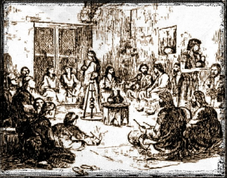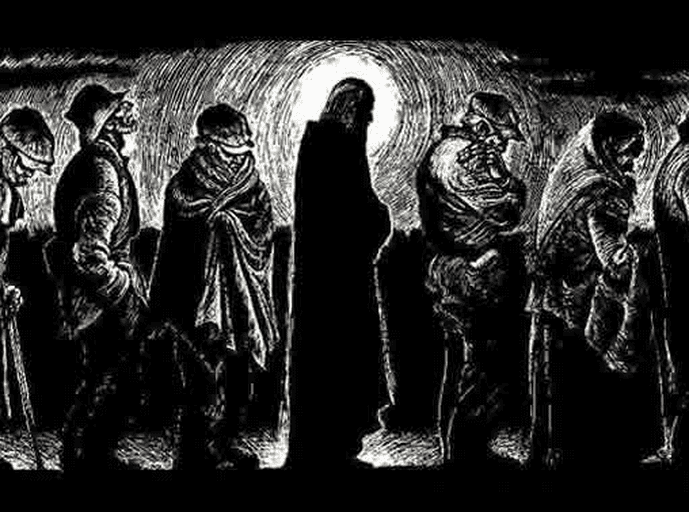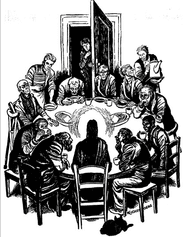IV. The “Inner [One New] Humanity” Temple (aka "Inner Man") and the Revelatory Nature of the Church There are enough hints, allusions, word plays, and inferences to draw the conclusion that “the saints who are at Ephesus” (Eph 1:1) are indeed God’s temple (2:18–22; 3:6, 8–10, 14–19) in contrast to the plethora of pagan temples in the region and who are the fullness of God in Ephesus et al. They are God’s temple, with Messiah Jesus as its cornerstone (2:20), a building created and being built, not by human hands (2:11) of stone, wood, and metal, but by God’s words, through his apostles and prophets, made effective and filled with his Spirit, ever expanding, right there in (a) place (and the next place and then the next, etc.). The church (a local church) is being built as a house-temple to reveal the mystery of God’s reconciliation work in Messiah Jesus (Eph 3:5–10; cf. 1:9–10; 2:10). The reconciling work of the cross becomes the reconciling of flesh (i.e., people and systems and institutions, 2:11–16; 3:10; 6:10-15) in (a) place; the deconstructing of social and institutional powers, heavenly and earthly (cf. 1:10). The local church, as God’s temple where his fullness is housed (dwells), is to be a revelation of God, his mystery in Messiah. Set in contrast to contemporary (ANE) “temple” life, a corporate inference to Paul’s “inner man” seems most reasonable. In the previous paragraphs (Eph 3:1–13), Paul frames the following prayer (vv. 14–19) by, first, explaining the nature of his ministry and of the church as the revelation of the “mystery of Christ,’ which he already had alluded to as the “one new humanity” (2:15c), the incorporation of the Gentiles into church(es) (i.e., the promises of Christ through the gospel,” 3:6c). Thus, a fair reading of Ephesians 3 as a whole suggests that the church (a church) itself is a revelation of the gospel. Understanding the polemical temple backdrop to which Paul utilizes, there is further reason to read the revelatory nature of the church (a church) as appropriate to grasp the intent of his Ephesians 3 prayer. In other words, the church (a church) is a “thin place” where the mysteries (i.e., the revelation of the gospel) is revealed. The “thin place” is that sacred space, the place where the unseen mysteries of the heavenlies and the concrete places of the earth touch, cross, meet. A thin place is where one can walk in two worlds at the same time, the two worlds fused together, where the differences can still be discerned. As someone explained: “A thin place is a place where the boundary between heaven and earth is especially thin. It’s a place where we can sense the divine more readily.” This is why Paul prays as he does for the “saints who are at Ephesus” et al in verses 14–19 and offers the benediction in vv. 20–21 concerning ekklesia and all future generations of churches. The “one new humanity” (Eph 2:15c) is the very expression of the temple, the inner sanctuary where God is housed, where he speaks, and is revealed. The “inner man” (more so, the inner humanity) that is gathered in house-temple-churches (literally, in the homes and at the supper tables) are the revelation of the gospel of Christ. The church (more so, a church-gathered) as God’s temple is this “thin place.” V. The Corporate Church Implications: Revelatory Church Growth Outcomes 1. The habits of church life need to move away from the building-centered experience to be the church in (a) place: i.e., non-building-centered outcomes to determine church growth (it is the reconciling element of the cross among people that is being joined together and growing into a holy temple in the Lord, that is being built together into a dwelling place for God by the Spirit (Eph 2:20b–22): God’s new revelatory temple. 2. The habits of church go counter-cultural, moving away from a privatized Christian experience toward a corporate application of what it means to be the church in a place, a gathered-house-temple, with a concrete home (a neighborhood) address, where strangers and unequals (note the reconciliatory aspect I am suggesting) participate as church around a supper table [unlike a building-centered church experience, where neighborhood is absent]. 3. Since the stress is on the inclusion of Gentiles as fellow heirs and fellow-partners with believing Jews, part of the church’s revelation exists, as a gathered-temple/church, to be a visual (flesh of a neighborhood or community) that demonstrates reconciliation outcomes (based on Ephesians 2:11–22 and 3:1–13). 4. Church growth outcomes should reflect the realities of what it means to be God’s temple in (a) place: Outcomes measured in the language of neighborhood, reflecting the reconciliation of actual people (i.e., strangers and unequals, etc.). 5. Church growth outcomes should reflect the decision-making that removes barriers to accessing the Father and promoting what draws people into free access to the Father (as opposed to accessing a building). 6. Think cosmologically. Act locally (develop outcomes related to the local neighborhood and wider community).
0 Comments
III. Implications from Solomon’s Temple Dedication and Other OT Temple Texts (B) The semantic range of esō (inner), Solomon’s temple, and Ezekiel’s future temple. The sematic range of use of esō (inner) plays a corresponding role throughout the temple building project and in the restoration of the temple as envisioned by Ezekiel.[1] Although the New Testament use of esō as in Eph 3:16c, what is easily noted is that the use of esō, esōtatos, and esōteros is prevalent (widely used) in the 1 Kings and 2 Chronicles, as well as Ezekiel’s vision of the future temple, to describe the construction, design, furnishings, and direction of its structure and temple items. The esō-terms can refer to many parts, entrances, or directions within the temple structure and furnishings, but yet, it should not escape our notice that the inner court and the most holy place share in this words use as well. esō
esōtatos
esōteros
The temple construction and the Solomonic temple dedication prayer have numerous parallels, word-links, and conceptual association with both Paul’s Ephesians 2 “one new man” context and his Ephesian 3 prayer that references the “inner man.” The conclusion and consequence of the temple prayer and building is glory-filling 1. The event or consequence concluding construction of the temple was God filling the temple with his glory (presence, spirit, cloud). Another parallel, actually a type-antitype (an anti-parallel), is the reference that the glory filling the temple prohibited access, which is ironically reversed in the “one new man” and the mysterious consequence of Messiah Jesus’ work referred to in Ephesians 3. These texts indicate the equal and free access to the Father by believing Gentiles and believing Jews. We should see this in light of the redemptive results referred to in Ephesians 1: v. 6, to the praise of the glory of His grace; v. 12, to the praise of his glory; v. 14, to the praise of his glory. The same result occurs in Ezekiel at the conclusion of the restoration of God’s eschatological temple, namely the glory fills the temple.
2. The temple measuring language also finds its way into the Ephesians 3 prayer: see 1 Kgs 6:1-6; 2 Chron 1-5; cf. Ezek 40-47. Ezekiel’s new temple vision There is a strong link between Ezekiel’s restoration chapters (37-48) and the Ephesians 2 “one new man” and Paul’s Ephesians 3 prayer: 1. Ezekiel 43:5 (LXX), καὶ ἀνέλαβέν με πνεῦμα καὶ εἰσήγαγέν με εἰς τὴν αὐλὴν τὴν ἐσωτέραν [And the Spirit lifted me up and brought me into the inner court; and behold, the glory of the Lord filled the house.] The glory of God plays a key role, first in its departure in Ezekiel 1 and, then, in its return in chapter 43. Additionally, in Ezekiel 1 and 8, the prophet’s vision includes his “glimpse of part of the heavenly temple.”[3]
2. Measuring language: The dimensions given in the Ezekiel visions all seem to be God’s heavenly temple rather than a temple in Jerusalem, as Ezekiel 43:12 suggests in referring to “the top of the mountain.”
Ezekiel takes nine chapters to show specific measurements for this future eschatological temple.[4] G.K. Beale recognizes this same connection to the eschatological temple in Revelation 21 (“its length and width and height are equal”) and the measurement language in 1 Kings 5:17; 6:20–22; 7:9–10, even noting the dimensions of the “holy of holies” in 1 Kgs 6:20 ( length . . . and the breadth . . . and the height” of the holy of holies were equal in measurement).[5] 3. The inner reference in Ezekiel’s description of the restored, future temple
4. The dwelling language (not lexical, but conceptual):
5. The glory filled the inner court/temple/house (with an antecedent to the wilderness tabernacle).
The overall effect of the restoration and measuring of God’s people and, as well, his temple is to assure the exiles God will bring about his promises, his remedy for the condition of exile. Beale points out, the “theophany of Yahweh in his heavenly temple was intended to reassure the prophet that the faithful among the exiles were still related to the true heavenly temple, though the old one had been decimated.”[7] Measuring demonstrated surety of the vision and God’s abilityto bring it about. Zechariah 6:11–15 and the future temple. Zechariah 6 combines a wide range of themes found in Chronicles (Kings), Ezekiel, and, as well, Ephesians concerning the (future) temple: The Branch-Son-temple-builder and those “far off” come to rebuild the temple.
Isaiah 11, the Spirit, and Messianic wisdom. Interesting, in Isaiah 11 the Spirit of the Lord rests upon the Branch (Isa 11:2), that is, “the Spirit of wisdom and understanding” (πνεῦμα σοφίας καὶ συνέσεως), a word combination rarely used, is strongly associated with temple-building. The Ephesian parallels should be noted in Paul’s Ephesian prayers (1:10, 17; 3:10). Additionally, “wisdom” and “knowledge” is associated with the design and construction the temple (2 Chron 1:11, 12; 2:7, 12, 13). Paul connects wisdom (Eph 5:13) and Spirit in Eph 5:18, continuing to infer the corporate, local congregation reference to “inner man.” Eph 5:18 is a temple-filling (be filled in Spirit; note the plural) reference, similar as Paul’s prayer that the Ephesian congregation “be strengthened with power through His Spirit in the inner man” (3:16b).[8]
Footnotes
[1] Note the LXX utilizes esō, esōtatos, and esōteros with little lexical difference, save whatever the context is implying. [2] 1 Macc 9:54 (“the inner court of the Temple,” τῆς αὐλῆς τῶν ἁγίων τῆς ἐσωτέρας) [3] G.K. Beale, The Temple and the Church’s Mission: A biblical theology of the dwelling place of God (Downers Grove: InterVarsity, 2004), 337. [4] Jason Eric Beals, “National Restoration and the Divine Dwelling Place in Ezekiel 37:15–28,” Masters thesis (Master’s Seminary, Sun Valley, CA, April 2013), 12. Also see Schmitt and Laney, “Messiah’s Coming Temple.” Also Ralph Alexander, “Ezekiel,” 6:943-96; Cooper, Ezekiel, 349-428. [5] G. K. Beale, “Eden, the Temple, and the Church’s Mission in the New Creation,” J. Ev. Theol. Soc. 48/1 (March 2005) 5-31. [6] An interesting OT text in light of Paul’s words of prohibition (And do not get drunk with wine . . .) and the (likely) temple reference (i.e., πληροῦσθε ἐν πνεύματι, be filled in Spirit) in Eph 5:18. [7] See Beale, The Temple and the Church’s Mission, 337. [8] Also Daniel 2, 7, the heavenly powers, and the whole earth. Christ’s expanded rule over the cosmos exercises authority over both the earth and the heavens: this makes total sense, namely the role of the temples where to illustrate and provide the means to appease both the earthly rulers and the heavenly deities who control the life upon the earth. The reference to “heavenly places” points to a cosmological mission, as Paul’s prayer implies, becomes localized in Ephesus through his body, his fullness in that place. The Daniel 7 “Son of Man” is linked in language and concept to the Ephesians 2 “one new man” (and Dan 7-8 present the one-and-the-many concept between the Son of Man and the saints of the Most High). II. Weighing the Context and the Burden of Interpretation: Individual or Corporate?  Virtually every commentator affirms, without question, an individual referent for Paul’s Ephesians 3:16 phrase “inner man.” For most, with little to no explanation as to how anthropos (lit. man, human being) can be understood as “self” or how esō (inner) is a reference to the inner being (that incorporeal, ethereal, intangible, soul-ish, or heart aspect of the human being); [1] or, there is an immediate assumption, again with no explanation, that Paul has turned his prayer’s attention to the individual Christian—that is, the inner self of the individual believer.[2] Some appeal to similar Pauline expressions (i.e., Romans 7:22; 2 Corinthians 4:16) are typically made, assuming, as well, those texts are similarly individual referents. Nonetheless, given that the prayer as a whole and the surrounding context is highly corporate, the burden of interpretation, then, seems to be on those assuming an individualistic reference for Paul’s phrase “inner man” (ἔσω ἄνθρωπον). Max Turner helps refocus our attention on the corporate nature of Ephesians: Descartes, Enlightenment ‘man’, the Romanticists, Kant, Freud, Jung, and developments since, have placed the major emphasis of personhood on the inner self, the subjective and all-too-readily individualistic pole of experience, the world-interpreting (including ‘self-interpreting’) ‘I’. The first century Greco-Roman world, like so much of the modern Eastern and Southern worlds, was fundamentally different. Their concept of the ‘person’ (as with the Fathers!) is fundamentally much more dyadic, that is, essentially relational and group-orientated. The ‘person’ marks him- or herself by (a) what place she has in the wider society (e.g., her lineage); (b) with which society she is identified (e.g., her ethnos, her city, etc.); (c) his or her upbringing, education and training (under which teachers, involving what skills, and understanding, etc.); and (d) his or her accomplishments, in terms of public deeds, and visible ‘persona’. Within such a cultural setting, introspective and psychologising accounts of the ‘self’ may be expected to be found little more frequently than the proverbial mare’s nest.[3] In other words, Paul, in Ephesians, is helping to revise the church’s mental and social map of their world in that place (Ephesus et al.).[4] As they had experienced before coming to faith in Messiah Jesus, the temples and their experience of the temples revealed the heavenly mysteries and created habits that molded them according to the deities represented in and through the temple; now, however, as God’s temple, they are to do essentially the same, yet now, reflecting God in Messiah Jesus. Their natural “bandwidth” was limited by their previous social and cultural experience. As suggested in the words of Leonard Sweet, “When the root metaphors change, so does everything else.”[5] This seems to be what Paul is after in Ephesians. Paul’s reference to “inner man.” Paul utilizes almost the same exact phrase in Romans 7:22 as he does in Ephesians 3:16. Both are set within prepositional phrases, the only difference is kata (according to is used in the Romans 7:22 text and eis (into) in the Ephesians 3:16 text.
For most commenting on one or both these texts, they are considered the same and simply taken as the “inner person” of an individual. Lincoln has a long discussion and rationale (essentially the only commentator to do so) for taking “inner man” as an individual reference; however, he makes inferences from what he considers relevant Greek- and Hellenistic-world authors concerning the dualistic “notion” of “an inward person” or “the person within the person.” The argument seems to start with the assumption of what “inner man” means (i.e., inner, real self), not whether it actually means inner person; then, Lincoln precedes assuming a dynamic similarity to such Hellenistic writers’ use of other linguistic words and phrases (not the actual phrase, however). Furthermore, without much consideration, Lincoln indicates that the “new man” (Eph 2:15c) and the “inner man” (Eph 3:16c) are not to be equated. Nonetheless, he only cites inferences and concepts of “the inner person” from, what are obviously, platonically influenced dualistic, writers. Yet, there is no exact or even any closely resembling phrase among Greek writers and thinkers.[7] Barring any appropriating from Gnostic or Platonic thought, Paul is, still, unique in forming this phrase.[8] Also, to go with the reading, one must still argue that Paul was offering a Greek understanding of a person within some dualistic framework and not, the natural assumption, from an Old Testament or Hebraic understanding of the referent. The apostle does not draw on any other relevant or traditional language used to describe a human being in this way.
1. In the Ephesians 3 prayer, Paul is entreating God on behalf of the whole church in Ephesus, which is made plain by (a) the repeated plural “you” address, (b) the second person plural verbal expressions, (c) implied by the reference to the “fullness of God” in verse 19, and (d) the benediction call toward the whole church (which I maintain should be heard as local to the Ephesus et al. house-churches rather than some notion of a universal church) in verses 20–21. All components of the prayer are directed at the whole of the church being addressed (vv. 16, 18, 19c), which suggests there is either an exception being made in the reference to “inner man” or “inner man” has, as does the rest of the prayer, a corporate reference. It is the church, which is Jesus’ (earthly) body, that is God’s fullness, according to Paul’s previous description in 1:23.[10] Identifying “inner man” as the individual in Eph 3: 16c would mean Paul has changed the framing of his prayer. It seems more reasonable to retain the corporate thread in vv. 16–19, which would imply that “inner man” is to be understood corporately. 2. The Ephesians 3 prayer parallels both Paul’s previous prayer (1:15–23), which is most certainly addressed to the whole of the church (in Ephesus et al.) and, as well, the affirmations made throughout chapters 1-3 concerning God’s action in Jesus toward the whole Ephesus et al. church. In fact, Paul “reuses many of the words and ideas of his earlier intercession, 1:17–19,”[11] implying a similar focus. For example, in the first prayer (1:14–23), Paul prays that the church would comprehend “what is the surpassing greatness of His power toward us who believe” (v. 19). This has parallel meaning in the Ephesians 3 prayer when Paul prays that the church “be strengthened with power through His Spirit” (3:16), thus allowing a continued corporate focus, which would include the intent of the phrase “inner man.” 3. Other references to anthropos regarding the nature of the church, i.e., the one new man (2:15c; including 4:22–25) in Ephesians fall squarely on, not the individual Christian, but the corporate unity of the new Gentile-Jew co-fellowship, house-temple in and through Messiah Jesus. Furthermore, the pattern of the whole phrase “inner man” as a prepositional phrase mirrors Paul’s “one new man” reference in 2:15c:
4. The reason for the prayer itself (3:14) is seen in the immediate paragraph where the imagery and concept of the “one new man” is apparent: that the Gentiles are fellow heirs and fellow members of the body, and fellow partakers of the promise in Christ Jesus through the gospel (3:6). These are the same words and concepts used to describe the incorporation of the Gentiles as an element of the Ephesians 2 “one new man.” 5. The reference to “glory” (according to the riches of His glory, v. 16b) draws the readers back to the trio of verses (1:6a, 12c, 14c) that are tied to the result of the Father’s action toward and on behalf of the church, namely that all, on account of God’s action in Messiah, through faith, have access to the Father’s presence (2:18; cf. 3:12):
Paul’s trio-reference to God’s “glory” carriers resonance of God’s temple presence (which will occupy are attention later in the essay). The OT is filled with references to Yahweh’s presence either being associated with his “glory” or with “glory” indicating God’s actual presence in earthly space and time. Given Ephesian’s liturgical rhetoric and Paul’s very concrete reference to the church as God’s temple (2:19-22), there is no doubt that the apostle “has drawn on the manner in which the OT writers expressed the divine presence and manifestation of God in the temple.”[13] Paul’s repeated use of “glory,” particularly as the ultimate result of God’s action in Messiah (i.e., to [note into, eis] the praise of His glory, 1:12, 14; cf. 1:6 ), we should, therefore, understand the term “coextensive with the concept of God’s glory filling the temple.”[14] Thus, there is a strong tie to the access to the Father, which is at the heart of the two preceding paragraphs:
This not only links the “inner man” to the “one new man,” it, furthermore, also strengthens the corporate reference of the whole prayer. 6. The three escalating hina clauses in 3:14–19 imply that all the clauses are intended to be taken corporately, that is the prayer is applied to the church as a whole. This is particularly recognized in Paul’s final and ultimate hina clause that contains the requested result and content[15] of his prayer to the Father: that you [the church in Ephesus et al.] may be filled up to all the fullness of God (3:19c).
The phrase “the inner man” comes in the first of three escalating requests; not necessarily three independent clauses, but components that build (i.e., are stacked) or further explain Paul’s entreaty on their behalf. Note the use of corporate language in the Ephesians 1 prayer also ends with reference to the church being “the fullness of God” (1:23b), which seems to be the case here in the Ephesians 3 prayer (cf. 3:19c). The first hina clause, which contains the phrase “inner man,” is a request that the whole of the “saints in Ephesus” be strengthened with/in power that results in Messiah dwelling in their hearts as gathered-church(es). The “dwelling” seems to imply the need for “inner man” to be a corporate reference, reflecting what it means to be the fullness of God in Ephesus. 7. The last of the hina clauses, the final request--that you may be filled up to all the fullness of God, 3:19c—draws from Paul’s first church reference to “fullness” in 1:22-23: And He put all things in subjection under His feet, and gave Him as head over all things to the church, which is His body, the fullness of Him who fills all in all. It is clear that the earthly body of Messiah, the church, is the fullness of God.[17] The whole prayer (3:14-19), that is, its content (i.e., the choice of words and imagery), is to request that the Father on behalf of the “saints who are at Ephesus” (1:1) to realize who they are in Ephesus as gathered-church, God’s one new man (i.e., one new humanity) the house-temple, God’s dwelling place; thus, they are to know/comprehend/experience the fullness of God (as the one new humanity, the inner man). Additionally, the “one new man” is the house-temple of God, that is the dwelling place of God, which has a conceptual reference to Paul’s “fullness” references elsewhere. 8. Paul prays the Ephesus church is strengthen in the inner man “through His Spirit” (3:16b). All references to the actions or person of the Holy Spirit situated in Ephesians are corporate references to church (cf. 5:18). Paul’s “inner man” would be the sole exception if it were a reference to the individual Christian. More explicitly, the church had been just described as God’s new temple, a dwelling of God in the Spirit (2:22c)—a specific reference to the (local) church as a whole.
10. The agricultural and building imagery in 3:17 associated with the “inner man” (3:16c) is also drawn from (or is parallel to) the Ephesians 2 “one new man.” Paul uses οἰκοδομὴ συναρμολογουμένη αὔξει (2:21) and ἐρριζωμένοι καὶ τεθεμελιωμένοι (3:17), a blend of building, growing, and agricultural imagery to indicate the growth of the church. This language, as in chapter 2, is more suited to reference the growing/building nature of the (local) church. There is also a connection to the Ephesians 2 “one new man” with the old/new man in Ephesians 4 through the growing and building language. The connection to the Ephesians 3 prayer and the “inner man” can be seen in the en agape (in love) parallels—both connected to the growing imagery. [See chart II.1.10] 11. Finally, Paul’s measuring language in verse 18 not only is addressed corporately to the church also suggests a reference to the church as temple: may be able to comprehend with all the saints what is the breadth and length and height and depth (3:18). This would further indicate a link between the Ephesians 2 “one new man” and the church being addressed in Paul’s culminating prayer in 3:14–19. As will be discussed below, measuring language in the Bible has multiple levels of meaning. The Ezekiel 37 background to the “one new man” and its Ephesians 2:11–22 context is important here: Ezekiel 37, a vision of restored Israel, leads into a vision of a restored temple, resulting in God’s glory returning to the temple (43:1–5; cf. 1:6, 12, 14; 3:16, 21). The dimension language in Ephesians 3:18 (τὸ πλάτος καὶ μῆκος καὶ ὕψος καὶ βάθος) is the same language used of Ezekiel’s description of the eschatological temple’s altar in Ezekiel 41:22. Furthermore, the highest prevalence of dimension language in the LXX is located in Ezekiel 40-47, where it is used to refer to the dimensions of the new temple. The above review of the context and the repeated emphasis on the corporate nature of the prayer-petition and on the church in Ephesus as God’s house-temple strongly suggests that Paul’s reference to the “inner man” should demand a corporate reading. This places the burden of interpretative rationale on those who read “inner man” as an individual rather than a corporate reference. In the following section we will focus on the potential implications of Paul’s use of the Solomon temple dedication and other OT temple texts on both the Ephesians 3 prayer and the significance of the term “inner man.”
Footnotes [1] Stirling, “Transformation and Growth,” 139. There is also a problem determining what this “inner man” is without degenerating into a dualistic or platonic view of a human being, moving even into Gnostic understandings of human existence—certainly this is not Paul’s view of the human being. Secondly, how does one have the “inner, deeper, human aspect” of one’s self know anything? How would—based on this prayer—one allow, make the “inner man” in this way strengthened?
[2] The tendency to translate the Greek word anthrōpos (man) in some texts as “self,” or even “human nature” seems more an applicationally-leveraged rendering (i.e., interpretation) than one based on the social and intellectual worldview of the NT era. Those associated with “deeper life” circles or experience-centered faith (and worship) tend to build spiritual life doctrine of human nature, an individualistic Christian life, and personal application from the translations rendering Paul’s reference to “new man” or “old man” as “new self” or “old self,” which spills over into the apostle’s reference to the “inner man.” Although significant, application for personal spiritual (or deeper) life experiences should not anachronistically move from the English rendering to Paul’s meaning. Since Paul’s new man is a corporate concept, I translate the Ephesians 2:15 text as “new humanity,” an appropriate verbal expression, which fits the apostle’s original intention, keeping the Adam referent (see Romans 5-6) intact. This should be considered when weighing Paul’s meaning and intention of “into the inner man” [Eph 3:16c, my translation]. [3] Max Turner, "Approaching 'personhood' in the New Testament, with special reference to Ephesians,” EQ 77.3 (2005): 211-33. [4] Assuming churches in someone’s houses in and around Ephesus, Laodicea, and Colossae. [5] Leonard Hjalmarson, No Home Like Place: A Christian Theology of Place (Portland, OR: Urban Loft, 2014), 110; “Seven Questions.” [6] Walt Russell, “Insights from postmodernism’s Emphasis on Interpretive Communities in the Interpretation of Romans 7,” JETS 37/4 (December 1994): 511-27. [7] Lincoln, Ephesians, 205. [8] Paul’s reference to the “inner man” in Romans 7:22b is heard through the assumption that Paul is completely referring to himself, i.e., the “I,” throughout Romans 7. However, there has been some discussion that Paul, perhaps, represents a corporate reference, such as a community. Even Ridderbos (Paul: An Outline of His Theology) sees the potential that Paul is not just Paul, but Paul the Pharisee (under the law) and Paul the new community of God (under the Spirit). So, perhaps, the parallels and/or similarities between Paul’s meaning of “inner man” in Romans 7 and “inner man” in Ephesians need more review and further consideration—beyond mere individualizing the text. [9] William Hendriksen, Exposition of Ephesians (Grand Rapids: Baker Book, 1967), 171. [10] Ephesians 1:22–23: “And He put all things in subjection under His feet, and gave Him as head over all things to the church, which is His body, the fullness of Him who fills all in all.” [11] Ernest Best, A Critical and Exegetical Commentary on Ephesian (Edinburgh: T&T Clark, 1998), 339 [12] The same phrase occurs in Romans 7:22, similarly with the definite article preceding ἔσω. Given the very likelihood that Paul is using himself as a representative of the whole congregation no longer under Law vs. under grace, perhaps the antecedent for ἄνθρωπον is found in Paul’s Adam-new Adam referenced in Romans 5-6. [13] Stirling, “Transformation and Growth: The Davidic Temple Building in Ephesians,” PhD thesis, University of St. Andrews, 138; Arnold, Ephesians, 116. [14] Ibid., 138. [15] The hina clauses seem to function as both the content of Paul’s prayer (i.e., indirect address), but also the result he is seeking on their behalf. [16] Author’s modified NASB translation. [17] Whole church in Ephesus (i.e., Asia Minor), as well as the local congregations (i.e., gathered-house-churches) were equally the fulness of God, not lacking in anyway. I. Leveraging the Concept of Sacred Space reFocuses a Socio-Rhetorical Interpretation In order to hear more effectively Paul’s Ephesians 3:14–19 prayer, a socio-rhetorical approach can aid the reader in the listening process. The goal here is to recognize that the original audience had experienced life in time and space, which promoted habits and beliefs that developed their social reality different from our own. This approach assumes a tapestry of “cultural textures” have been interwoven into the text of Ephesians.[1] Such an interpretative tactic allows the socio-cultural location in Ephesus et al. and, as well, their habits and beliefs—namely, the cultural, social and habitual background noise of their daily lives—to help us hear how the original readers would have heard what we are now reading in Paul’s Ephesians 3 prayer. The nature of Paul’s style and his identification of the church in Ephesus as God’s household-temple (Ephesians 2:18–22) will be explored, which will also help focus our potential interpretation of his phrase in Ephesians 3:16, the “inner man.”
Witherington further identifies Ephesians as “epideictic rhetoric,” a style that displays dramatic tones that would have been appropriate for a document intended to provoke an attitude of worship, giving a heightened liturgical imagination to its hearers/readers designed to produce a community-centered response. Although “epideictic rhetoric” typically did not call for a specific action, Paul, nonetheless, harnesses this style to “enhance knowledge, understanding, or belief”[6] in what God in Messiah Jesus has done on behalf, in the midst of, and through the “the saints who are at Ephesus” (1:1). The style and content of Ephesians 1-3 seem to focus our attention in just this direction. The “epideictic rhetoric” can clearly be seen in the two Ephesian prayers (1:15–23; 3:14–19), the second of which (3:14–19) contains our text under consideration (3:16c). Paul offers these prayers on behalf of the church in the greater Ephesus area, each provoking a heightened imagination of God’s action in Messiah toward the house-churches (cf. 3:20–21). Paul prays that God would increase their comprehension of God’s action and what it does in and through them as household-gathered-churches. The prayers are self-actualizing and actually fulfills what is requested of God on behalf of the Ephesus church—the prayer is initially answered as the believing community hears the words of Paul’s petition. He beseeches God to open their hearts as a local[7] believing community so that they would expand and enhance their knowledge and experience of God’s powerful work in Messiah Jesus. The stacking and enhanced language and imagery not only fits the temple worship experience formerly encountered by the Ephesus believers, it also gives an enhanced imagery for the new house-churches, who, as they are gathered, are God’s fullness (1:23) and temple-house (2:19–22) in Ephesus et al. (The new temple in town!) And, although often taken and preached individualistically (i.e., to the believer), the culminating verses of this highly liturgically charged and lofty worship section (1:3-3:19) has a benedictory call addressed to the whole of the church in Ephesus. Now to Him who is able to do far more abundantly beyond all that we [that is, the church, the one new man; cf. 2:15ff.] ask or think, according to the power that works [which is the content of the two prayers, the resurrected and ascended Messiah] among us [en humin, among us, i.e., the one new man], to Him be the glory in the church and in Christ Jesus to all generations forever and ever. Amen (3:20–21) In other words Paul’s prayer is: “may the essence and benefits described in this homily (in 1:3-3:19) effectually become a reality for the gathered-church in this place, for all generations; may what God has brought about through his actions in the death and resurrection of Messiah Jesus become the belief and action among and through the (local) church, His body, which is his fullness (cf. 1:23; 3:19).” These prayers, which take up a rather large of amount of word count in the first three chapters of Ephesians, “are acts of praise and adoration [themselves], even though they include petitions on behalf of the audience.”[8] The requests (themselves) are to lift the congregation as a whole, who is God’s temple in Ephesus et al., into the realm of reality that reflects what Paul has written already in 1:3–14 as well as 1:15–23 and 3:1–13. The rhetorical function of the paragraph, 3:14–19, with its doxology and benedictory call that follows (vv. 21–22), is to enlarge the vision of the congregation as agathered-church in that place, God’s temple-house in Ephesus et al.[9] The “epideictic rhetoric” is being used to arouse the emotions, pulling on the collective congregational imagination, the realization of what it means to be seated with Messiah Jesus in the heavenly places (2:5; 3:10), to be God’s fullness in Christ, that is conveyors, illustrators, a display of God’s mystery (1:23; 3:10) as a gathered-house-temple-church in that place. Paul uses this sacred-space and enhanced, liturgically-charged and hierophantic prayer to mold, corporately, the “saints who are at Ephesus” to recognize their own relationship (as a bound together social group, i.e., a church) is how God is revealing the gospel (Eph 3:6). Sacred space implies the stylistically veiled polemic target. The lack of an obvious polemical target in Ephesians suggests to many that the Letter is universal in nature, focusing on the “invisible” church. However, perhaps we should look in a different direction (i.e., listen differently) for Paul’s purpose. As Paul has highlighted in chapter 2, the Gentile believers are to understand a new identity apart from their former temple-life and the powers associated with those temples (cf. 2:1–11) and are, now, to conform to a new identity as the household-temple in the Lord (cf. 2:11–12; 4:17–32). In Ephesians 2, the Gentile audience is first reminded of their former “deadness” as they once walked (i.e., lived) according to the evil powers of creation (2:1–3), which was learned and expressed by their former temple-life, and, second, to grasp their new standing in “the heavenlies” in Messiah (v. 6). Now, “the saints who are at Ephesus” are to rethink everything as God’s new creation, the one new man (2:15c), God’s new humanity, his temple-household (2:19–22). The church, with the Gentiles, has become God’s sacred space throughout Asia Minor.
Paul’s temple referent as sacred space (in Ephesus) is significant to any discussion for both the topic of ecclesiology (i.e., the nature of the church) and for church growth; first, because of the nature of sacred space itself and, second, because Paul harnesses the imagery to portray the church as growing.[11] The temple reference and imagery suggests an important interpretative hermeneutic within Ephesians itself. In the ancient Mediterranean world and cultures, temples were at the very center of everyday life defining reality—socially, politically, religiously, and for defining and understanding of humanity (including personhood), making it very difficult to divide these categories in the life of people. This was true of the pagan cult-temples and, as well, true for Israel through their Solomonic temple experience. As the gospel moved into Gentile territory, and specifically within non-Jewish communities outside the life of a synagogue, it would be necessary for both the Gentile and the Jewish believer to understand their new orientation for life and humanity (cf. Eph 2:11–22; 3:1–6).
Footnotes
[1] I.e., an approach to reading literature that focuses on values, social-worldviews, and beliefs in the texts; reading texts as performances relevant to its particular historical and cultural social-location; it presupposes that a text is a tapestry of interwoven textures, social, cultural, ideological, sacred texture. This fits well with how Paul writes and the word choices he made in the Ephesian Letter. [2] This in no way means the Letter is less polemical in desired outcome; the question would be, then, how does the rather non-polemical style act as a polemic against any perceived opposition, obstacles, or barriers to the gospel of Messiah Jesus? The remaining section will offer a potential answer to this question. [3] Ben Witherington, The Letters to Philemon, the Colossians, and the Ephesians: A Socio-Rhetorical Commentary on the Captivity Epistles (Grand Rapids: Eerdmans, 2007), 4; refers to G.A. Kennedy, New Testament Interpretation through Rhetorical Criticism (Chapel Hill: University of North Carolina Press, 1984), 32; B. Reicke calls it “Asianism.” (“It was called ‘Asian’ style because its foremost representatives came from Asia Minor, and it was characterized by a loaded, verbose, high-sounding manner of expression leaning toward the novel and bizarre, and careless about violating classic ideals of simplicity. . . Our epistle was undoubtedly written in conformity with the rules of the Asian school which was still important during the first Christian century”). [4] Witherington, The Letters, 4. [5] For the inappropriate leveraging of application to determine interpretation, see chapter 6 of my Wasted Evangelism: Social Action and the Church’s Task of Evangelism (Wipf & Stock, 2013). [6] Witherington, The Letters, 7. [7] Although most take Ephesians as a sermonic Epistle concerning the universal church (i.e., the “invisible” church), it seems more likely that Paul’s intended audience is the household churches gathered throughout Asia Minor. What we refer to as The Letter to the Ephesians was meant to be circulatory, meaning it was to be read elsewhere, which seems what is to be inferred by the reference in Colossians 4:16 that the Colossian Letter was to be read elsewhere as well as the Letter coming from Laodicea (cf. Col 2:1, 13, 15). Additionally, as will be discussed later in the article, there is no reason to think the Letter’s polemic can not be addressing specific churches in Asia Minor, i.e., Ephesus et al., rather than some ambiguous concept of a invisible, universal church. [8] Witherington, The Letters, 270. [9] Ibid., 270. [10] Perhaps we should read the Ephesians 4 “leadership list” in light of this as well. [11] I had thought the images, descriptions, and teaching Paul renders on “the Church” in Ephesians was intentionally universal in nature—that is, “the Church” capital “C” in Ephesians is about the universal church as opposed to being about the or a church (small “c”) local. I believe I was incorrect on this. As Paul starts the letter he wrote, “To the saints who are at Ephesus” (1:1), making it local. While I grant the circulatory nature of this Letter (i.e., to the churches of Asia Minor, and is probably the Letter referenced in Colossians as “the letter from Laodicea,” 4:16), the Letter known to us as Ephesians is about the local church at least, the community of believers in a local area (geographic and municipal in make up). I believe this shift has implications for defining biblical church growth.
 Typically, church growth outcomes are limited to numbers of people indicated by an increased averaged attendance at one specific type of event (i.e., a weekly worship service) in one room (i.e., the “sanctuary” or space where a weekly worship service is held) at a particular addressed-place or tallied as increased paper membership at an annual congregational meeting. This is a building-centered form of church growth, which is foreign to the concept of “church” in the New Testament. On the other hand, Paul’s Letter to the Ephesians imagines believers “growing into a holy temple in the Lord” that forms “a dwelling of God in the Spirit” (2:21–22). The habits and experience of most who attend a building-centered church seem to focus on the individual Christian: sermons target those in the pew with generalized easy-to-make individualized application; the style and design of the service focuses on an audience of one to ensure faithful attendance; and, programs and activities are developed to meet personal needs. Furthermore, most building-centered churches are neighborhood-less, disconnected from the built space of the addressed-church building. By design or default, the building-centered experience is designed to move people away from their respective neighborhoods in order to develop and isolate the building-centered church community—again, separated from its built environment; programs and activities are designed to keep people returning to the “building.” However on the other hand, Paul’s reference to “the inner man” (Eph 3:16c) and the very temple background reverberating throughout Ephesians, as well as, the immediate context (i.e., Eph 3:1–13, 14–19, also 20–21) focuses us, the reader/hearer, on the importance of rethinking “church” and helps to establish a biblical understanding of church as sacred space. This essay seeks to establish Paul’s “inner man” (3:16c) as a corporate temple reference (befitting the context) and as an allusion to back to the Ephesians 2:15c “one new man,” that is God’s growing church-temple. This essay offers a corporate reading of Paul’s Ephesian 3:16 “inner man” reference, which reinforces the gathered-temple-church, the one new man, as sacred space, the liminal space space between (the heavenlies and a local neighborhood, let's say); and, as such, the local temple-church has revelatory significance for disclosing the wisdom and mysteries of God (cf. 3:8–10). This implies that church growth outcomes go (far) beyond mere numbers of people and may include, as the antecedent one new man suggests, social, demographic, and justice outcomes as well. The ensuing study will develop this thesis (I) through leveraging the concept of sacred space as a socio-rhetorical interpretive-model; (II) by weighing the context to determine a “corporate” or “individual” reading of Paul’s use of “inner man” in Ephesians 3:16; (III) by showing that Solomon’s temple dedication and other Old Testament temple texts have implications for a corporate reading of Paul’s “inner man” reference; (IV) by summarizing how a corporate reading “inner man” that denotes the revelatory nature of the temple-church; and, (V) by presenting a list of inferred outcome relevant to church growth.
The local church as the “thin place” and “the space between”: “Thin place,” a sacred place or space where unseen mysteries of the other world (i.e., “the heavenlies”) and the material places of the earth touch. A “thin place” is where one can walk in two worlds at the same time, a place of liminality—a place where the two worlds (seen and unseen) are fused or mingled together, yet where distinctions can be discerned. “A thin place” is where the boundary between heaven and earth is especially narrow, a place where a sense of the divine is more readily perceived. The church (a local church) as God’s household-temple is such a “thin place.” The “space between” is the common or transitional space where boundaries are fluid, a mix of human activity, specifically that space between the build environment. The church (a local church) is such a “space between” [from C. M. Anderson, “The Sacred “Thin” Space Between: (Eph 3:16): The Temple- Church as Revelation of God's Reconciling Mystery and Its Potential for Church Growth Outcomes” (paper)].
*This is the third instalment of quotes from my presentation on "Church (local), the poor and their neighborhood," which are focused on applying the Bible, especially in the context of "neighborhood." For all the posted "Church (local) quotes >>
 Sometimes we should be deeply impacted by a text of Scripture, not so much as an encouragement or a comfort, but seriously scaring us to death. We are conditioned to seek solace, comfort, encouragement, even exhortation, in the Bible. We are told and, perhaps, have taught others to hold on to its promises. But, this is only half right. We should be consoled by texts meant to console, yet scared to death by texts meant to slay us. Ephesians 3:1-13 is one such text of Scripture (despite most preachers never presenting this path of relevance or application from this pericope of Paul’s words–at least to my knowledge). “For this reason I, Paul, a prisoner for Christ Jesus on behalf of you Gentiles—assuming that you have heard of the stewardship of God’s grace that was given to me for you, how the mystery was made known to me by revelation, as I have written briefly. When you read this, you can perceive my insight into the mystery of Christ, which was not made known to the sons of men in other generations as it has now been revealed to his holy apostles and prophets by the Spirit. This mystery is that the Gentiles are fellow heirs, members of the same body, and partakers of the promise in Christ Jesus through the gospel.” Here some of my thoughts that arise from Paul’s words to the church in Ephesus:
I recall, now too many years ago to acknowledge, telling some bible college students that were complaining about the rule that all hats, including baseball caps, were to be taken off inside a campus building: “If you can’t take off those caps now, what makes you think you’ll be able to die for your faith in some god-forsaken land when all indication seems to indicate that God has abandoned you?”
If you are a Christian (especially a Christian leader), you shouldn’t be able to read Ephesians 3:1-13 with any measure of comfort either—and it should scare the hell out of you, as well. The question remains, nonetheless, where will you go? To whom will you go to? With whom will you live and ministry so that all, that is those now outside the church, may have access to the Father?
|
AuthorChip M. Anderson, advocate for biblical social action; pastor of an urban church plant in the Hill neighborhood of New Haven, CT; husband, father, author, former Greek & NT professor; and, 19 years involved with social action. Archives
February 2024
Categories
All
|
Pages |
More Pages |
|




 RSS Feed
RSS Feed